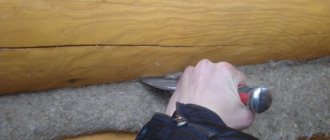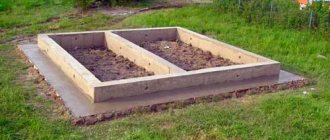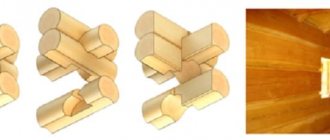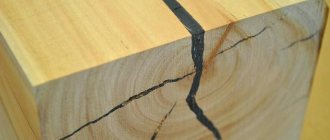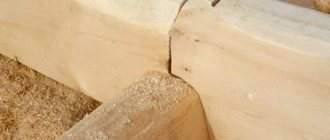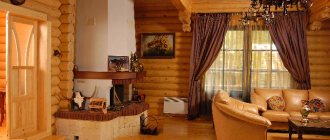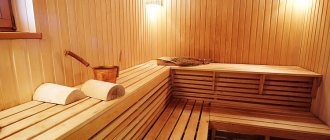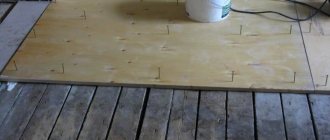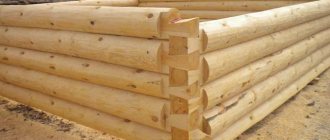So you’ve come to the idea that it’s time to build a bathhouse. The bathhouse has been built. But here a natural question arises: how to cover the seams in an already built bathhouse, which are very visible. No matter how tightly the timber or frame is laid during the construction of a bathhouse, the seams still remain. But it is through them that the precious heat will escape, without which comfortable conditions for visitors to your bathhouse are impossible. It follows from this that in winter, heat in a timber bath can only be maintained if all joints, cracks and seams between the crowns are sealed
Wood itself, due to its natural characteristics, can be deformed, changing volume and size. And in the bathhouse itself, due to constant temperature changes, this will be especially noticeable, since cracks appear on the logs themselves, and gaps are likely to form between the blocks. All this will lead to the fact that the bathhouse itself becomes very unprotected from natural phenomena. This problem is completely solvable, and modern insulation means will not require large material costs. But insulation begins during the construction of the bathhouse, when the initial sealing and sealing of the bathhouse seams is carried out. And from this moment a completely natural question arises: “What should I use to cover the seams in the bathhouse and ensure its thermal insulation?” As thermal insulation, you can use traditional materials that are used when laying crowns: tow, moss. Modern materials that provide thermal insulation in wooden buildings are also suitable for sealing external seams in the bathhouse.
What is sealant used for?
Sealing compounds are used to improve thermal insulation characteristics and eliminate various defects in natural wood coatings. Today, a variety of objects made of wood are very popular. They have not only advantages, but also disadvantages.
For example, as a result of exposure to precipitation and temperature changes, the elements of the log house become covered with cracks and shrink, which negatively affects the heat retention indicators. Gaps and seams require periodic sealing. Previously, short-lived improvised materials were used to solve the problem. But eventually the process of wood rotting began. Moisture led to mold and other related problems.
A much more effective solution is to use special modern sealants, which can be used to seal the crown joints of a log house. This technology is called “Warm seam”
Old traditional sealing materials will not fail
If, when deciding how to seal seams in a bathhouse, you settled on native Russian materials: moss, tow, jute, then the process itself will be more labor-intensive and special skills will be required. Natural sealants have many advantages over artificial ones:
- They contain 100% natural materials, to which environmentalists cannot make any claims.
- Moss and jute do not let warm air out of the room and keep cold out.
- They have excellent absorbent properties, which is very important in constantly wet bath rooms. Therefore, there is no need to worry about the walls starting to rot.
But there is one inconvenience in using such materials: you will have to monitor the tightness of the seams during the entire operation of the structure, and not just after shrinkage.
Back to news list
Composition requirements
Sealing compounds are versatile. They are used to eliminate defects in log houses, rafters, floor coverings, gaps and cracks in window frames, stair steps and other wooden elements.
High-quality wood sealant meets the following standards:
- resistance to sudden changes in temperature, direct sun and precipitation;
- plasticity and performance of its functions when seams are enlarged;
- high-quality grip on wood;
- natural shade;
- water-repellent properties that prevent the development of mold and mildew;
- long service life.
How to caulk correctly
The caulking process involves insulating the seams between logs using fiber tape. Practice shows that only if the joints are sealed, high-quality thermal insulation can be guaranteed. The tape, in turn, should be knocked into a tight roller. It is necessary to ensure that the fiber ribbon does not twist, because... twisted fibers have significantly lower thermal protection efficiency.
Types of sealing compounds
Restoration of seams is carried out using household or professional means. They differ in composition and cost. Professional sealants are much more expensive and not as easy to work with as with household compounds, so you will need some experience. Household sealing compounds are easy to use and are designed for use by ordinary housewives.
Before purchasing a sealant, you must carefully read the information about the selected product indicated on the tube. Colored sealants are available for sale, which are used in cases where the surface is not planned to be painted after the product has dried. Manufacturers also offer white sealing compounds, which are later painted. They are well suited for removing defects in white window frames and doors.
Processing of natural wood elements is usually carried out using silicone, acrylic and polyurethane sealants. Manufacturers also offer thiokol and bitumen compositions.
Non-hardening solutions in the form of mastic, which are sold in special bags, are ideal for outdoor work. These products contain silicone components.
Bituminous sealants are a good solution for repairing cracks in tiles and eliminating imperfections in walls. These products contain rubber and are only available in black.
Universal solutions that can be used for various interior jobs also deserve attention. Such pastes provide reliable protection against drafts.
How to seal gaps between logs in a bathhouse
The presence of a huge number of advantages inherent in wood when used as the main building material forces owners to put up with some disadvantages. It is a consequence of these disadvantages of the material that the periodically arising need to seal the cracks in the bathhouse between the logs occurs. Obviously, you shouldn’t delay carrying out such work, as drafts may form, which will lead not only to a decrease in the level of comfort from visiting the bathhouse, but also to the appearance of colds and other diseases.
Today, several options are used to seal cracks in the log house of a bathhouse. The most popular are:
- natural moss. A traditional way to protect joints and seams between logs. This material is considered one of the best when used as inter-crown insulation;
- tow. An equally classic way to solve the problem under consideration. To increase adhesion, the material is often impregnated with liquid gypsum or cement mortar;
- hemp. Another natural method that allows you to effectively and reliably seal the cracks that have formed between the logs of the log house. The only drawback of this option is its higher cost when compared with the methods of performing the work described above;
- modern sealants and sealants. The most popular are synthetic compounds that are applied using special sprayers. This significantly increases work productivity. The main requirement for using synthetic sealants is complete shrinkage of the house. Usually the material is used in combination with special mounting tape.
Under no circumstances is it recommended to use silicone and polyurethane compounds or conventional polyurethane foam. These materials do not have sufficient resistance to sunlight, and in addition, do not prevent wood from rotting. That is why it is recommended to use either classic sealing options that involve the use of moss, tow or hemp, or modern and no less effective synthetic sealants.
WOODENWOOD sealant - high quality and efficiency
WOODENWOOD is one of the leaders in the segment of sealing compounds for wood. The product is produced in Slovenia. The results of numerous studies have demonstrated the high effectiveness of this development.
Key advantages of WOODENWOOD acrylic composition:
- Long service life. Correct installation ensures an operational life of up to 30 years.
- Environmental Safety. The sealant can be used for both external and internal work; it is completely safe.
- Thoughtful composition. The product provides protection for the inter-crown joints of the log house from the formation of mold.
- Flexibility. The product can stretch even 100%.
- Attractiveness. Treating the seams with this solution makes the appearance of the house complete.
- Efficiency and ease of use. Applying the sealant is easy and dries quickly.
- Soundproofing. The sealing composition not only improves thermal insulation characteristics, but also provides protection from unnecessary sounds.
The production of WOODENWOOD sealants is carried out on modern equipment using high-quality raw materials. Finished products are checked several times, so the consumer receives a truly high-quality product. At least once a year, the manufacturer conducts separate experiments in order to optimize the technical characteristics and properties of the product. WOODENWOOD is one of the best combinations of cost and quality in this segment.
Basic rules for insulating a log house
The construction of a log house involves laying logs with inter-crown insulation, and in some cases without it. At the same time, it is impossible for the logs to fit together as completely as possible, which leads to drafts and penetration of cold. The situation gets worse after one year, when the house begins to shrink, forming new cracks. Not only cold air penetrates through them, but also moisture, leading to rotting of the wood.
The caulking procedure is carried out several times. The first procedure is carried out after 12-18 months from the date of construction, when the house has given the necessary shrinkage. A repeat procedure will be organized after another 24-36 months, depending on the condition of the structure. It is possible that the procedure will have to be repeated in the future. This depends not only on the quality of the materials used, but also on the quality of work.
Caulking is not so easy; you need tools and practical experience, so in most cases specialists are invited. To achieve maximum effect, the log house must be insulated on both sides, both inside and outside. In general, the amount of work turns out to be quite significant, requiring significant effort and time.
It is worth taking into account such an important point as increasing the height of the house. On average, it will add about 50-70mm after the first caulking, so it is not recommended to carry out interior finishing work before insulation.
The cost of work depends on several factors:
- Dimensions of the log house;
- The quality of its construction;
- Type of inter-crown insulation.
Basic recommendations for choosing a product
Manufacturers offer sealants in buckets, briquettes, tubes or tapes. Thanks to this, you can choose exactly the option that suits your needs. For example, if it is necessary to process long seams, it is recommended to use a composition in the form of a tape. You need to approach the issue of choosing silicone sealant very seriously. There are a large number of low-quality products on the market and we are not talking about defects here. Many companies offer customers material with poor performance properties, saving money when choosing materials. To avoid annoying mistakes, it is better to buy only those products for which the seller is willing to provide a certificate.
Typically, the desire to save money leads to the purchase of sealant that contains low-cost organic components, for example, kerosene or oil. Sometimes there is no mention of this on the packaging, since the manufacturer indicates that the tube only contains sealant.
It must be understood that the presence of a large number of impurities seriously impairs the quality of the composition. As a result, after some time the product shrinks, and during installation there is low adhesion and minimal elasticity. Another possible scenario is fading or yellowing of the sealant, which has a very negative effect on the appearance of the seams.
How to seal gaps between boards
During the process of wood shrinking and drying, deformations often occur in some building structures where this material is used. One of the frequently asked questions is how to seal the cracks in the bathhouse between the boards. It can equally likely apply to both the ceiling and the floor of the building.
Currently, three sealing options are most often used - using sealants, putty intended for wood and construction foam. Of course, if the gaps are large, replacement of damaged or deformed boards can be used, however, in this case, we are not talking about sealing, but a full repair with the replacement of faulty elements or structural parts. Another way to get rid of the problem in question is to prepare homemade mixtures, which usually contain a binder (paint, glue) and filler in the form of gypsum or sawdust.
It is up to the owner of the building to decide how to seal the cracks in the bathhouse. If you do not want to prepare any repair compounds yourself, it is enough to purchase any ready-made sealant from the large number available on the market today. The most popular are pigmented silicone and acrylic colored compounds. The main requirement when using them is careful adherence to the instructions for use.
An effective solution to the problem of sealing cracks in the ceiling of a bathhouse is tinted gypsum putty. This material is easy to use and affordable. It is great for small crevices and can be simply sanded down with sandpaper to create a more aesthetically pleasing look. The main disadvantage of the material is the need to repeat the sealing procedure every 2-2.5 years, which is explained by the insufficient durability of the putty.
19/09/2017
Sealing inter-crown seams - key steps
The procedure begins with preparing the surface to be treated. It is necessary to remove dust and dirt using rags. A similar solution is used when working in a newly constructed building. Old wood may contain resinous substances or mold, so a regular rag will not work.
If there are serious defects, it is necessary to remove the upper part of the mold using a scraper, and then sand the wood with sandpaper or a sander. If the wood has been previously treated with oils, the top layer must also be removed.
The second option is the use of contactless technology. The abrasive-jet technique can be used when working with different types of wood. The idea is to remove various particles from the surface of the material using a jet of air and sand under serious pressure. Ultimately, a natural pattern appears on it.
After removing the top layer, it is very important to treat the material with various antiseptics that will prevent the development of fungi. Next, the wood is varnished. In some cases, there are grease stains on the material. A solvent will help solve the problem; after using it, the wood must be washed with water, adding a little soap solution to it.
At the next stage, insulating material is placed between the seams. It minimizes the gaps between individual logs. The lack of insulation leads to cracks and freezing of the walls, and its use protects the wood from the negative effects of moisture. Instead of inter-crown insulation, polyethylene foam bundles are often used. In case of large gaps, polyurethane foam is used.
Materials for caulking seams
Today, the most widely used methods for insulating wooden log houses are:
- Tow. Material with low thermal conductivity, not conducive to the formation of bacteria. Working with it is difficult, and the resulting result cannot boast of aesthetic appearance;
- Linen. Elastic and durable material at an affordable price. Its weakness is its poor resistance to insects and love from birds, pecking the fiber from the seams;
- Jute. The breathable material is practically impervious to rotting, reliably retains heat inside the building, and is not of interest to birds. Being an imported product, it has a fairly high cost;
- Moss. An outdated type of insulation originally used. Its use is possible only during the construction of a house, and it is impossible to insulate it for an already finished structure.
Using caulking can significantly increase the thermal efficiency of a building, make it more comfortable, and reduce monthly heating costs. In turn, work must be carried out after the log frame has shrinked, but before finishing work is completed.
You can caulk a house in one of two ways:
- Stretch. Used for small gaps by filling the seams.
- To the set. The material is formed into a ball and then sealed with loops. Suitable for cases with large gaps between logs.
Preventing cracks: tips and tricks
Most often, the problem of cracks in a log house log is solved by sealing it with sealant. However, this is already a radical decision, although it is more correct to take measures to prevent the immediate appearance of cracks in the wood.
The first step is to create the right conditions for drying lumber.
- The owner must remember the following point: the number and size of cracks directly depends on the drying time of the wood. Therefore, it is recommended to carry out this operation for as long as possible.
- Another important point, which can also affect the appearance of cracks in the structure of the log, is the creation of such conditions for the wood so that it does not lose its natural ability to breathe.
The tree needs to be provided with a constant flow of fresh air . This can only be done if an optimal temperature regime is created and the material is protected from direct sunlight.
By creating such conditions for the tree, you can be sure that moisture will evaporate from all layers of wood evenly, and this will significantly reduce the likelihood of cracks and other unpleasant defects in the structure of the log.
What happens if you don't repair cracks in logs?
The logs of the log house, covered with a web of cracks, as well as deep crevices, look extremely unattractive, which is why the aesthetics of the structure suffer. But besides this, cracks are a source of many different problems that bring the moment of the first repair closer.
Taking this into account, it is necessary to be very attentive to the condition of the logs and take action at the first appearance of cracks. The main negative point that manifests itself if there are cracks in the logs is a significant decrease in the strength characteristics of the building.
This happens because at the stage of developing the building project, strength limits were laid into it, taking into account the homogeneity and integrity of the material. The appearance of cracks in the logs of a log house can significantly reduce the service life of the material , and because of this defect, destruction of the entire supporting structure can begin.
Caulk or sealant for a log house: advantages and disadvantages of traditional materials
Using traditional materials still works well today
Log caulking technologies have changed little since ancient times, and until now there have been no significant changes in this area. To insulate the crown joints, we used the old proven method: caulk with moss and tow. In recent years, jute and linen wool have also become popular. The main advantages of these materials:
- ✔absolute environmental friendliness;
- ✔formation of a favorable microclimate in the room due to the “breathable” seam;
- ✔uniform thermal insulation;
- ✔minimal hygroscopicity with good vapor permeability (provides a comfortable level of air humidity in the house);
- ✔low cost (compared to high-quality sealants for log caulking, the listed materials are very inexpensive).
Simple, cheap and cheerful. For this reason, sealing a log house with fibrous materials still suits many people. Although no one denies the existence of such problematic issues as:
- ✘ The labor-intensive process of caulking with similar materials. In this case, the work is carried out in two stages - directly at the time of construction and after completion of the shrinkage of the log house. The most important thing here is to lay it out as evenly as possible on all sides.
- ✘ Destruction of insulation. Natural materials are impeccable from the point of view of environmental friendliness, but they are not very durable. Therefore, you will have to get used to the need to replace them every few years. However, the same jute insulation “lives” for quite a long time. Therefore, there is room for discussion.
- ✘ The appearance of gaps between logs. Natural materials are impeccable from the point of view of environmental friendliness, but they are not very durable. Therefore, you will have to get used to the need to replace them every few years. However, the same jute insulation “lives” for quite a long time. Therefore, there is room for discussion.
- ✘ Aesthetic aspect. A caulked seam looks beautiful, but along with shrinkage, the authenticity of the structure is compromised and you will have to “repair the mess” all over again. Caulking with sealant retains its attractiveness much longer.
As you can see, there is really a lot to think about here, and finally choosing which is better - caulk or sealant - will not be so easy.
Modern means of sealing cracks in wooden buildings
There are no special means for sealing seams between logs, since sealants known to everyone are used for this. But not everyone is suitable for such work, and here's why.
Conventional polyurethane foam is not suitable due to the constant, albeit small, mobility of the logs. Thus, the foam will only begin to crack and peel over time. Silicone sealant is not suitable due to the fact that it does not absorb moisture well. And since the tree, as usual, does this very well, and also rots well, rot will certainly form in those places of the log where there are problems with sufficient evaporation.
All of the above makes such sealants unsuitable for sealing seams between logs in wooden houses or barns. And the ideal solution is actually to use polyurethane sealants. The latter can be actively used both inside and outside the building, as they perfectly withstand temperature changes and retain their properties even in the most severe frosts. Such sealants are excellent, unless we are talking about those sold in cylinders; they can withstand the effects of solar radiation without reducing their insulating properties even from the most serious doses of ultraviolet radiation.
Thermal insulation of a steam room with your own hands
Every owner of a plot of land who decides to build a log bathhouse on it inevitably faces the need to insulate the steam room. Of course, a lot depends on the location and layout of the room. But in order to most effectively maintain optimal temperature conditions and reduce operating costs, it is recommended to carry out steam and waterproofing in the steam room .
Insulation of the ceiling in the steam room
Experts advise starting to insulate any room with ceiling insulation. The peculiarity of this work is that to insulate the ceiling, twice as much insulation is required, since its layer must be larger. During the heating of the bathhouse, the hot air generated by the stove accumulates in the ceiling area. Thus, the process of insulating the ceiling in a steam room from the inside can be described as follows:
- First, you need to take a roll of paper and secure it to the surface of the ceiling so that there is a sufficiently wide overlap at the joints.
- Now you need to install wooden blocks with a cross section of 5 x 5 cm on the paper, the space between which will subsequently be filled with sealing material.
- We take monolithic foil and aluminum adhesive tape and seal each fragment of the ceiling. This must be done very carefully so as not to miss a single joint, crack or gap. Using this material, you can ensure high-quality sealing of the room, as a result, steam and condensation will not escape from it. If certain circumstances prevented you from obtaining aluminum foil, then instead you can use wax paper or thick cardboard, which must be pre-treated with drying oil.
- Next, using tape, you need to process each joint to protect the ceiling from moisture.
- Now you need to install small bars with a cross section of 2 x 3 cm directly on the foil. Such a measure will create conditions for proper air exchange of the ceiling structure.
- We attach decorative trim directly to the slats, which you can choose at your discretion.
Please note that the construction of a frame bathhouse necessarily requires thermal insulation of the ceiling . If the bathhouse is built from logs, then this work need not be carried out. Here you can limit yourself to installing boards at least 6 cm thick on the ceiling and laying mineral wool in a layer of 15 cm.
Insulation of walls in a bathhouse
Before you start insulating the walls of the steam room, you need to prepare for this work. First of all, you need to treat all detected joints, gaps and cracks with sealant or plaster. Wait until the material dries, after which you can insulate the bathhouse.
Wall insulation is carried out according to a similar scheme as in the case of the ceiling. However, special attention should be paid to creating conditions for high-quality ventilation . The step-by-step process of insulating wall structures is as follows:
- In order for the foil to adhere well to the surface, before laying it is necessary to bring wooden blocks with a cross-section of 40 x 40 mm to the wall of the steam room. They should be placed in a horizontal plane.
- It is necessary to lay sealing material no more than 40 mm thick in the space between the slats.
- Now you need to take a construction stapler and attach the foil directly to the bars, doing this very carefully so that it is taut and there are not even small gaps.
- Now we need a special aluminum tape, which needs to be used to cover all the joints on the foil cladding.
- We nail wooden blocks directly onto the aluminum layer, but this time they should be placed in a vertical plane.
- After all the above has been done, the facing material can be attached to the structure.
Waterproofing the floor in the steam room
After you have insulated the ceiling and walls of the steam room from the inside, you can move on to the next stage - waterproofing the floor. Different methods are used here, the choice is made taking into account the material of construction, which can be wood or concrete.
Concrete floor insulation
Most often, owners use this method of waterproofing a steam room. It is ideal for a room where the base is made of concrete and subsequently it is planned to install tiles. Waterproofing work is carried out step by step as follows:
- First, it is necessary to eliminate all unevenness in the subfloor. You should not leave even the slightest bumps, cracks or other defects.
- We take bitumen mastic and cover the floor with it, then wait until it dries.
- Place roofing material or plastic film on the dried layer of mastic.
- At this point, the work on insulating the floor is completed and you can proceed to laying ceramic tiles.
Second way. It is more labor-intensive, but it perfectly protects the floor from moisture and the material from damage. To ensure high-quality insulation of a concrete floor in a steam room, you need to do the following:
- We take plywood sheets and install it on the subfloor.
- For waterproofing, you can take waterproofing and lay it directly on the plywood. Keep in mind that its edges must be placed on the wall.
- Now we need aluminum tape, which we need to use to seal all the joints of the waterproofing layer and the walls.
- Any gaps found must be sealed using a hair dryer.
- Make sure there are no joints or gaps left on the wall. Now you can attach the reinforced mesh, and concrete mortar is poured on top of it.
- After waiting for the concrete screed to harden, you can begin laying floor tiles, after which we move on to decorative cladding.
Wood floor insulation
If the base in the steam room is made of wood, then its waterproofing can be done using a similar method as in the case described above. The step-by-step instructions involve performing the following steps:
- At the initial stage, you need to fix mineral wool mat insulation under the joists, which should be laid in a layer of at least 15 cm.
- Roofing felt or a more modern alternative - euroroofing felt is placed directly on it.
- Now you need to pay attention to the wooden surface and treat it with an antiseptic composition. This will help provide protection from rot, insect damage and spontaneous combustion.
- The subfloor is laid directly on the roofing felt and they begin to cover it with clapboard.
- At the final stage, decorative cladding of the floor structure is performed.
Advantages of log houses
But first, I would like to go through the many advantages of such buildings, which made them so popular among our compatriots, and on a global scale in general. So, let's focus on the main ones:
- Environmentally friendly. Houses made from natural materials are completely safe for the health of the people living in them. Moreover, a person in wooden houses gets sick less, has higher body tone and vigor;
- Walls made of wood, with similar durability and strength, will be much thinner than their brick counterparts. So these houses have more space;
- Wood is a very mediocre conductor of temperature. Thanks to this, such a home is cool in summer, and heat loss to the outside is minimal in winter. Consequently, such a structure warms up faster, and less resources are spent on maintaining comfortable temperature conditions;
- Wooden houses are lighter than concrete or brick ones, so the construction of a massive foundation is not required;
- Wooden walls are very pleasing to the eye, so you can save a lot on finishing activities.
And this is only a small part of the advantages that such buildings have. Listing all or even most of them would be a very lengthy process. But already what is mentioned above is enough to understand the reasons for the newly increased popularity of the tree. It is important that much of the above may not be available if the joints between the logs are not properly insulated.
